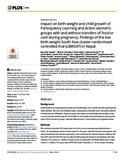| dc.identifier.citation | Saville NM, Shrestha BP, Style S, Harris-Fry H, Beard BJ, Sen A, et al. (2018) Impact on birth weight and child growth of Participatory Learning and Action women’s groups with and without transfers of food or cash during pregnancy: Findings of the low birth weight South Asia cluster-randomised controlled trial (LBWSAT) in Nepal. PLoS ONE 13(5): e0194064. https://doi.org/10.1371/journal.pone.0194064 | |
| dc.description.abstract | Background: Undernutrition during pregnancy leads to low birthweight, poor growth and inter-generational undernutrition. We did a non-blinded cluster-randomised controlled trial in the plains districts of Dhanusha and Mahottari, Nepal to assess the impact on birthweight and weight-for-age z-scores among children aged 0–16 months of community-based participatory learning and action (PLA) women’s groups, with and without food or cash transfers to pregnant women.
Methods: We randomly allocated 20 clusters per arm to four arms (average population/cluster = 6150). All consenting married women aged 10–49 years, who had not had tubal ligation and whose husbands had not had vasectomy, were monitored for missed menses. Between 29 Dec 2013 and 28 Feb 2015 we recruited 25,092 pregnant women to surveillance and interventions: PLA alone (n = 5626); PLA plus food (10 kg/month of fortified wheat-soya ‘Super Cereal’, n = 6884); PLA plus cash (NPR750≈US$7.5/month, n = 7272); control (existing government programmes, n = 5310). 539 PLA groups discussed and implemented strategies to improve low birthweight, nutrition in pregnancy and hand washing. Primary outcomes were birthweight within 72 hours of delivery and weight-for-age z-scores at endline (age 0–16 months). Only children born to permanent residents between 4 June 2014 and 20 June 2015 were eligible for intention to treat analyses (n = 10936), while in-migrating women and children born before interventions had been running for 16 weeks were excluded. Trial status: completed.
Results: In PLA plus food/cash arms, 94–97% of pregnant women attended groups and received a mean of four transfers over their pregnancies. In the PLA only arm, 49% of pregnant women attended groups. Due to unrest, the response rate for birthweight was low at 22% (n = 2087), but response rate for endline nutritional and dietary measures exceeded 83% (n = 9242). Compared to the control arm (n = 464), mean birthweight was significantly higher in the PLA plus food arm by 78·0 g (95% CI 13·9, 142·0; n = 626) and not significantly higher in PLA only and PLA plus cash arms by 28·9 g (95% CI -37·7, 95·4; n = 488) and 50·5 g (95% CI -15·0, 116·1; n = 509) respectively. Mean weight-for-age z-scores of children aged 0–16 months (average age 9 months) sampled cross-sectionally at endpoint, were not significantly different from those in the control arm (n = 2091). Differences in weight for-age z-score were as follows: PLA only -0·026 (95% CI -0·117, 0·065; n = 2095); PLA plus cash -0·045 (95% CI -0·133, 0·044; n = 2545); PLA plus food -0·033 (95% CI -0·121, 0·056; n = 2507). Amongst many secondary outcomes tested, compared with control, more institutional deliveries (OR: 1.46 95% CI 1.03, 2.06; n = 2651) and less colostrum discarding (OR:0.71 95% CI 0.54, 0.93; n = 2548) were found in the PLA plus food arm but not in PLA alone or in PLA plus cash arms.
Interpretation: Food supplements in pregnancy with PLA women’s groups increased birthweight more than PLA plus cash or PLA alone but differences were not sustained. Nutrition interventions throughout the thousand-day period are recommended. | |


